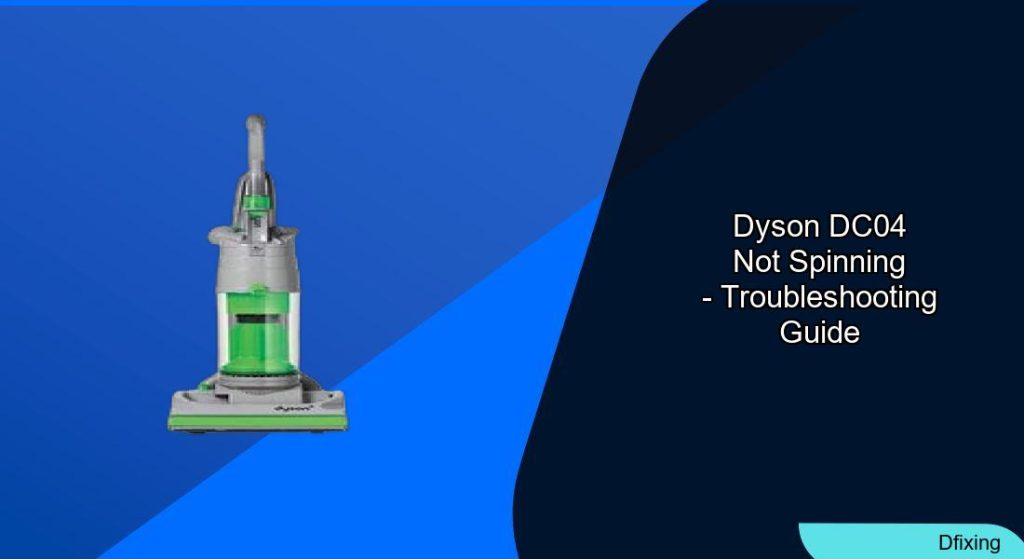A Dyson DC04 with a non-spinning brush bar can turn routine cleaning into a frustrating task. Homeowners often notice reduced suction, loud noises, or ineffective debris pickup, especially on carpets. This guide walks you through diagnosing and repairing the issue, whether your model uses a clutch or not. From identifying mechanical jams to replacing worn components, you’ll gain actionable insights to restore your vacuum’s performance and extend its lifespan.
Affiliate disclosure: As an Amazon associate, We'll earn a commission for every successful order through our affiliate links in the article. However, you won’t be charged anything for this.
The problem often stems from a faulty clutch, tangled hair buildup, or a worn belt. For clutch models, misalignment or a damaged clutch assembly prevents the brush bar from engaging. Non-clutch variants may suffer from debris jams or electrical faults. This article breaks down the repair process into clear steps, including disassembly, part replacement, and maintenance tips. By the end, you’ll know how to troubleshoot like a pro and avoid costly service calls.
Diagnosing Brush Bar Issues in Dyson DC04
Clutch vs. Non-Clutch Models: Key Differences
Dyson DC04 variants fall into two categories: clutch and non-clutch models. Clutch-equipped versions (e.g., “Allergy,” “Animal,” or “Absolute” models) have a knob on the left side of the base. The clutch disengages the brush bar when the vacuum is upright, protecting the motor. To test it, recline the vacuum and check if the brush bar spins. If it doesn’t, the clutch may be faulty. Non-clutch models should spin the brush bar continuously, regardless of position.
Common Symptoms and Causes
A grinding noise, weak suction, or a stationary brush bar typically points to:
– Hair or debris buildup around the brush roller or spindle.
– Worn or misaligned belts connecting the motor to the brush bar.
– Faulty clutch assembly in clutch models.
– Damaged bearings or electrical connections in the brush head.
Step-by-Step Repair Guide
Tools and Safety Precautions
Gather these tools:
– Phillips and flathead screwdrivers
– Needle-nose pliers
– Replacement clutch ($40 approx.) or belts ($10)
– Small container for screws
Safety first: Unplug the vacuum, let it cool, and work in a well-lit area.
Disassembling the Base Unit
- Remove the Base Plate: Unscrew and gently lift the base plate.
- Access the Clutch (Clutch Models): Locate the clutch assembly connected to the motor. Use pliers to detach the belt and pry out the old clutch with a flathead screwdriver.
Replacing the Clutch
- Install the New Clutch: Align the assembly and press it into place.
- Reattach the Belt: Loop the belt around the motor and brush roll using pliers.
- Reassemble: Secure the base plate and test the brush bar in reclined position.
Cleaning the Brush Roller and Spindle
- Remove the Brush Roller: Twist off the end cap using a spoon or coin.
- Cut Hair Buildup: Trim tangled hair between bristles with scissors, avoiding the bristles themselves.
- Clean the Spindle: Use a screwdriver to remove debris behind the spindle.
Electrical and Mechanical Maintenance
- Inspect Wires: Secure or replace frayed wires in the brush head.
- Check Bearings: Spin the bearings manually; replace gritty or seized ones (size 625).
Troubleshooting Common Failures
Hair Buildup in Hard-to-Reach Areas
Hair often accumulates behind the spindle or in the turbine mechanism. Use Torx screwdrivers to remove guards and clear obstructions. For Syntec models, release the rear screw to free trapped hair.
Belt Alignment and Replacement
Misaligned belts cause slipping or vibration. Ensure the larger belt (beater bar) and smaller belt (motor) sit securely on their shafts. Replace worn belts promptly.
Clutch Engagement Test
If the brush bar stops easily when manually touched during operation, the clutch is likely worn. Replace it following the steps above.
Frequently Asked Questions (FAQ)
Why does my Dyson DC04 brush bar only spin when reclined?
This is normal for clutch models. The clutch engages only when the vacuum is in the cleaning position.
How often should I clean the brush roller?
Inspect and clean the brush roller monthly, especially if you have pets, to prevent hair buildup.
Can I replace the clutch myself?
Yes. With basic tools and care, clutch replacement is a manageable DIY task.
What causes a grinding noise from the brush bar?
A grinding sound often indicates seized bearings or a faulty clutch. Clean or replace the affected components.
Are third-party clutch assemblies reliable?
Rebuilt or third-party clutches work well, though original Dyson parts are recommended for optimal durability.
Conclusion
A non-spinning brush bar in your Dyson DC04 isn’t a dead-end issue. By following this guide, you can diagnose and fix problems ranging from simple debris jams to clutch failures. Regular maintenance—like cleaning hair buildup and inspecting belts—prevents future issues. If repairs feel overwhelming, consult a professional, but with the right tools and patience, most fixes are achievable at home. Keep your Dyson DC04 running smoothly and enjoy efficient cleaning year-round.







